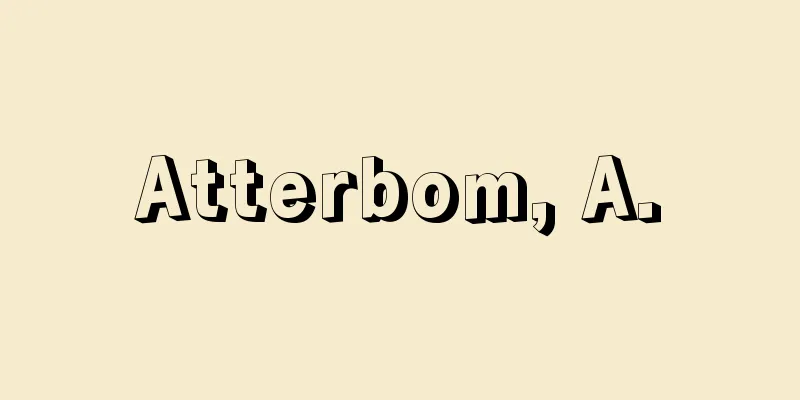Steam locomotive - steam locomotive

|
A locomotive powered by a steam engine. It is also called SL for short. [Shoji Matsuzawa] historyIt was Trevithick of England who applied the steam engine to railway vehicles and created the steam locomotive, which ran on rails for the first time in 1804. Later, in 1825, Stephenson's Locomotion was used for the world's first commercial railway operation between Stockton and Darlington. Furthermore, in 1829, the Rocket, built by Stephenson's son Robert Stephenson, won a locomotive competition to be used between Liverpool and Manchester, and was used in commercial operation the following year. Since then, the superior performance of steam locomotives and the possibility of their practical application have come to be generally recognized. The Rocket's structure had the Stephenson valve gear, a fire-tube boiler, an exhaust mechanism to improve combustion, and a system that directly transmitted the piston power to the driving wheels via a main rod, all of which were fundamental to the structure of a locomotive. Subsequent steam locomotives followed these models and developed with numerous improvements, becoming the driving force behind the development of railways around the world. The first practical steam locomotives in Japan were imported from Britain in 1872 (Meiji 5), 47 years after Britain, prior to the opening of the Shinbashi-Yokohama line the previous year, with 10 cars. In 1880, Hokkaido's Horonai Railway imported locomotives and railway technology from America, and in 1889, Kyushu Railway imported them from Germany, and subsequently, government railways and private railways continued to import them. The first domestically produced locomotive was the 860-type locomotive, built in 1893 at the government railway's Kobe factory under the guidance of a British engineer. The second locomotive, the Daisho-go (7150-type), built entirely by Japanese people, was built by the Hokkaido Colliery Railway in 1895. After that, private locomotive manufacturing companies were established, and domestic production became more common. After the nationalization of the railways in 1906 (Meiji 39), models were standardized, locomotive manufacturing technology improved, and in order to encourage domestic production, from the Taisho period onwards, all locomotives, except for special ones, were domestically produced. The first fully domestically produced locomotives were the 9600 freight type in 1913 (Taisho 2), and the 8620 passenger type the following year. In 1919, the C51 passenger type, with a driving wheel diameter of 1,750 mm, the largest on narrow-gauge railways at the time, was manufactured, and in 1923, the powerful D50 freight type was manufactured, both of which reached world-class standards. In 1928 (Showa 3), as the Showa era began, a three-cylinder C53 express passenger locomotive was manufactured for main lines, following a global trend. Based on the designs and track records of previous locomotives, research and improvements were conducted and, from 1936 onwards, standard modern locomotives such as the D51 for main line freight, the C57 for main line freight, the C59 for main line freight, the D52 for main line freight, and the C58 for local line all-purpose locomotives were manufactured one after another. The heyday of steam locomotives came at the same time as the Second World War. After the war, in order to cope with the rapidly increasing passenger traffic, the C62, the largest in Japan, was manufactured for main line passenger use, and the E10 for gradient sections, but this was the last, and new production was discontinued in order to modernize the power source. Steam locomotives, which have contributed greatly to the development of railways, have features such as being relatively simple in structure, durable, inexpensive to manufacture, and capable of performing fairly challenging operations, but they are energy inefficient, emit smoke that causes discomfort to crew and passengers, and have many difficulties in maintenance and operation, so they have eventually been replaced by more efficient electric and diesel locomotives. Currently, steam locomotives are rarely used in countries with advanced railway systems. [Shoji Matsuzawa] kindsformThere are tender locomotives and tank locomotives. Tender locomotives are coupled with a tender car (tender) that carries coal and water, making them advantageous for long-distance operation, but as the forward direction is the normal driving position, a turning device (turntable) is required for turning around. Tank locomotives do not have a tender car, and only a portion of the locomotive carries coal and water, so they carry less coal and water and are not suitable for long-distance operation, but they have the advantage of being able to move forward and backward easily. The weight of the locomotive changes depending on the amount of coal and water, which also affects the tractive force. [Shoji Matsuzawa] Intended UseThere are passenger, freight and shunting locomotives. Passenger locomotives have fewer wheels and larger wheels in diameter to allow for high speed operation. Freight locomotives have more wheels and smaller wheels in diameter to allow for greater traction. Small tank locomotives are used for shunting. Freight locomotives are also used for passenger trains on steep sections, and two or three locomotives are sometimes coupled together to pull heavy trains. [Shoji Matsuzawa] The nature of the steam usedThere are two types: saturated and superheated. The saturated type uses the steam generated in the boiler as is. The superheated type uses the saturated steam after further heating it in a superheater tube. Since the end of the Meiji period, the more efficient superheated type has been used everywhere. [Shoji Matsuzawa] How to use steamThere are two types of locomotives: compound and simple. Compound is a system in which the steam used once in a cylinder is reused in another cylinder. Simple is a system in which the steam is exhausted after one use, and most new locomotives are superheated simple. [Shoji Matsuzawa] Number of cylinders(1) Two-cylinder type with one cylinder on each side (a pair), (2) Three-cylinder type with one cylinder in the center, and (3) Four-cylinder type with two pairs of cylinders (except for the Malay type). Two-cylinder type is the most common. [Shoji Matsuzawa] Special locomotive(1) The Malay type locomotive, which has two sets of cylinders and running gear; (2) The Abt type locomotive, which runs on toothed rails; (3) The Garratt type locomotive, which has running gear on two tenders, one at the front and one at the back, and which is bridged by the boiler frame; (4) The Shay type locomotive, which has its cylinders mounted vertically and turns the driving wheels with a bevel gear on the crankshaft; and (5) The fireless locomotive, which runs on steam only, which fills the tank from a stationary boiler. [Shoji Matsuzawa] structureBroadly speaking, it can be divided into the frame, boiler, running gear, braking equipment, auxiliary equipment, driver's cab, tender, etc. [Shoji Matsuzawa] FrameIt corresponds to the skeleton of a locomotive, and includes the boiler and driver's cab, as well as the cylinders and associated running gear, front and rear wheel bogies, couplers, etc. [Shoji Matsuzawa] boilerA steam generating device with a horizontally long cylindrical shape. There is a firebox on the driver's cab side, and it consists of a smoke tube that guides the combustion gas from there, a boiler body that contains water around it, and a smokebox with a chimney that exhausts gas and smoke. Auxiliary equipment for the boiler includes a feedwater heater, feedwater pump, and water injection device. [Shoji Matsuzawa] Running gearIt consists of a valve gear that allows the piston to move smoothly back and forth inside the cylinder, a main rod that converts the reciprocating motion of the piston into rotational motion and transmits it to the driving wheels, and other parts. [Shoji Matsuzawa] Brake systemA mechanism required for adjusting speed and stopping to ensure safe operation. It consists of a part that adjusts the braking force of the brake device and a part that transmits this force. Ancillary equipment includes an air compressor. [Shoji Matsuzawa] Assistive devicesThese include sand sprinkling devices, lubrication devices, lighting devices, smoke suppression devices, water sprinkling devices, automatic coal feeding devices, automatic train stop devices, heating devices, etc. All of these are necessary for the safe and smooth operation of locomotives. [Shoji Matsuzawa] CabThis is where the locomotive is operated. It consists of a roof and enclosure that covers the entire area, with the engineer's seat on the left facing the firebox and the assistant engineer's seat on the right. In the engineer's seat there are the instruments necessary for operation, such as the control valve handle, brake valve handle, and reverse gear handle, and in the upper center there are various pressure gauges, a steam distribution box, and a water level gauge. In the assistant engineer's seat there is a water injector. Also in the lower center there is the firebox opening and its operating device. These are instruments that monitor the status of each part and provide auxiliary functions necessary for the locomotive to continue operating normally. [Shoji Matsuzawa] TenderA car that carries coal and water for operation. Generally considered to be included in a locomotive as an attachment to the locomotive. [Shoji Matsuzawa] Running actionCoal is thrown into the fire chamber through the fire hole (heavy oil combustion is done by a burner) and burns in the combustion chamber (firebox). The combustion gases and smoke generated there pass through the large and small flue pipes, giving heat to the water around the flue pipes, generating steam, which is then discharged from the smoke chamber through the chimney. The generated saturated steam accumulates in the steam dome, and when the engineer pulls the control valve handle to start the engine, the steam passes from the control valve through the drying tube into the superheater header, from which it travels twice through the large flue pipe to become superheated steam (around 300°C), before passing through another superheater header and into the cylinder through a steam pipe. The steam that entered the cylinder alternates between the front and rear of the piston through a valve device, and as the piston moves back and forth, it is discharged from the discharge pipe through the chimney. At this time, the combustion gases and smoke in the smokebox are drawn out, improving the ventilation above the fire bed in the firebox. The reciprocating motion of the piston and piston rod is converted into rotational motion by the crosshead, which slides on the slide rod, and the main connecting rod connected to it, which acts on the crank pin of the main driving wheel, causing the driving wheel to rotate. At the same time, the other driving wheels connected to the connecting rods also rotate. [Shoji Matsuzawa] "The Latest Railway Vehicle Engineering" by Hiroshi Kubota (1982, Koyusha)" ▽ "Railway Dictionary" edited by Japan National Railways (1958, Transportation Cooperation Association) [Reference] | |©Toshihisa Watanabe "> Structure of a steam locomotive (C62 type) ©Shogakukan "> Major steam locomotives in Japan (1) ©Shogakukan "> Major steam locomotives in Japan (2) ©Shogakukan "> The history of steam locomotive development The sixth of the 7100-type steam locomotives imported from the United States. Manufactured in 1884. Used on the Horonai Railway. Railway Monument (designated in 2010) Otaru City, Hokkaido Otaru City Museum ©Otaru City Museum "> Shizuka locomotive 7150-type steam locomotive manufactured by Hokkaido Colliery Railway. Manufactured in 1895 (Meiji 28). It is the second domestically produced locomotive and the oldest domestically produced steam locomotive still in existence. It was named after Japan's victory in the Sino-Japanese War when it was completed. Railway Monument (designated in 2010) Otaru City, Hokkaido Otaru City Museum ©Otaru City Museum "> Daishougo steam locomotive Source: Shogakukan Encyclopedia Nipponica About Encyclopedia Nipponica Information | Legend |
|
蒸気機関を原動機とする機関車。略してSLともいう。 [松澤正二] 歴史蒸気機関を鉄道車両に応用して蒸気機関車をつくったのは、イギリスのトレビシックで、1804年初めてレールの上を走らせた。その後、1825年にスティーブンソンのロコモーション号は、ストックトンとダーリントン間で世界最初の鉄道営業運転に使用された。さらに、1829年、スティーブンソンの息子のロバート・スティーブンソンのつくったロケット号が、リバプールとマンチェスター間で使用する機関車の競作で優勝し、翌年からの営業運転に使用されてから、蒸気機関車の優れた性能と、その実用化の可能性が一般に認識されるようになった。 このロケット号の構造は、スティーブンソン式弁装置を有し、煙管式ボイラー、燃焼をよくするための排気機構、ピストンの力を直接主連棒により動輪に伝える方式など、機関車の機構の基本となりうるものをもっていた。その後の蒸気機関車は、これらが踏襲され幾多の改良が加えられて発達し、世界の鉄道の発展の原動力となった。 日本での実用の蒸気機関車は、イギリスに遅れること47年の1872年(明治5)新橋―横浜間の開業に先だち、前年にイギリスから輸入された10両が最初である。1880年に北海道の幌内鉄道(ぽろないてつどう)がアメリカから、89年に九州鉄道がドイツから、それぞれ機関車を鉄道技術とともに輸入し、その後も官設鉄道をはじめ各私設鉄道でも引き続いて輸入した。国産最初の機関車は、1893年に官設鉄道の神戸工場でイギリス人技師の指導により製作された機関車(860形)が第1号である。続いて1895年北海道炭礦(たんこう)鉄道で、日本人だけの手で製作された機関車「大勝号」(7150形)が第2号である。 その後民間の機関車製造会社も設立され、国産も盛んに行われた。1906年(明治39)鉄道国有化後に形式が標準化され、機関車製造技術も向上し、国産奨励のためから、大正以降は特別な機関車を除いては、すべて国産されることになった。本格的な国産機関車は1913年(大正2)の貨物用9600形であり、翌年の旅客用8620形である。1919年には当時の狭軌鉄道では最大の動輪径1750ミリメートルをもつ幹線旅客用C51形が、23年には強力な幹線貨物用D50形が製造され、世界的水準に達した。 昭和に入り1928年(昭和3)世界的な趨勢(すうせい)により、3シリンダーのC53形急行旅客用機関車が幹線用に製造された。それまでの機関車の設計と使用実績から研究と改善の結果、36年以降、標準近代形機関車として、幹線貨物用D51形、同旅客用C57形、幹線旅客用C59形、同貨物用D52形、ローカル線万能機のC58形などが続々と製造され、蒸気機関車の最盛期と同時に第二次世界大戦を迎えた。戦後は急増する旅客輸送に対応するため、幹線旅客用では、日本最大のC62形が、勾配(こうばい)区間用としてE10形が製造されたが、これを最後に動力の近代化のため新規製造は打ち切られた。 鉄道の発展に寄与してきた蒸気機関車は、構造が比較的簡単なうえじょうぶで、製作費も安く、かなり無理な運転が可能などの特長があるが、エネルギー効率が悪く、そのうえ煙の排出により乗務員・乗客に不快感を与え、保守、運用にも難点が多く、ついに効率のよい電気機関車やディーゼル機関車に職場を譲った。現在、鉄道先進国においては蒸気機関車はほとんど使用されていない。 [松澤正二] 種類形態テンダー機関車とタンク機関車がある。テンダー機関車は、石炭と水を積載する炭水車(テンダー)を連結しているため、長距離運転に有利であるが、前進方向が運転正位のため、折り返し運転には転向装置(ターンテーブル)が必要である。タンク機関車は、炭水車を有せず、機関車の一部に石炭と水を積載するため、炭水の量が少なく長距離の運転には向かないが、前後進が容易な利点がある。なお、炭水の量によって機関車の重量が変化するので、牽引(けんいん)力にも影響がある。 [松澤正二] 使用目的旅客用、貨物用、入換え用がある。旅客用は高速運転の必要から、動輪数が少なく動輪直径が大きい。貨物用は牽引力を大きくする必要から、動輪数が多く動輪直径が小さい。入換え用は小型のタンク機関車が用いられる。なお、勾配区間では旅客列車用にも貨物用の機関車を充当し、また、重量列車の牽引には2~3両の機関車を連結した重連運転を行うこともある。 [松澤正二] 使用蒸気の性質飽和式と過熱式とがある。飽和式は、ボイラーで発生した蒸気をそのまま使用するもの。過熱式は、飽和蒸気を過熱管でさらに高温処理をして使用する方式である。明治末からはすべて効率のよい過熱式が使われている。 [松澤正二] 蒸気の使い方複式と単式がある。複式は、一度シリンダー内で使用した蒸気を、もう一度他のシリンダーで使用する方式である。単式は、1回の使用で排出する方式で、新型機関車は大部分が過熱式の単式である。 [松澤正二] シリンダーの数(1)左右に1個(1対(つい))の2シリンダー式、(2)中央にもう1個を有する3シリンダー式、(3)2対のシリンダーをもつ4シリンダー式(マレー式を除く)がある。普通は2シリンダー式である。 [松澤正二] 特殊機関車(1)シリンダーと走り装置を2組もったマレー式機関車、(2)歯形レールを使って走るアプト式機関車、(3)前後の2台の炭水車に走り装置をもち、それらをボイラーの台枠で橋渡ししたガラット式機関車、(4)シリンダーを縦位置に取り付けて、クランク軸の傘形歯車で動輪を回すシェイ式機関車、(5)据え付けのボイラーから蒸気だけをタンクに充填(じゅうてん)して走る無火(むか)機関車などがある。 [松澤正二] 構造大別すると、台枠、ボイラー、走り装置、ブレーキ装置、補助装置、運転室、炭水車などに分けられる。 [松澤正二] 台枠機関車の骨格に相当するもので、ボイラーと運転室が据え付けられ、シリンダーとこれに関連する走り装置、前後輪の台車、連結器などが取り付けられている。 [松澤正二] ボイラー蒸気発生装置で、横長の円筒形状のもの。運転室側には火室があり、そこから燃焼ガスを導く煙管(えんかん)と、その周囲の水の入る缶胴と、ガスや煙を排出する煙突のある煙室部から成り立っている。ボイラーの付属機器には給水温め器、給水ポンプ、注水器などがある。 [松澤正二] 走り装置シリンダー内のピストンを円滑に往復させる弁装置と、ピストンの往復運動を動輪へ回転運動に変えて伝える主連棒や、動輪などから成り立っている。 [松澤正二] ブレーキ装置運転の安全を確保するため、速度の調整と停止に必要な機構。ブレーキ装置の制動力を加減させる部分と、これを伝える部分とから成り立っている。付属機器には空気圧縮機がある。 [松澤正二] 補助装置砂まき装置、潤滑装置、点灯装置、消煙装置、水まき装置、自動給炭装置、自動列車停止装置、暖房装置などがある。いずれも機関車の安全円滑運転に必要なものである。 [松澤正二] 運転室機関車の運転操作をするところである。全体を覆う屋根と囲みからなり、火室に面して左側が機関士席、右側が機関助士席である。機関士席には加減弁ハンドル、ブレーキ弁ハンドル、逆転機ハンドルなど運転操作に必要な機器類があり、中央上部には各種圧力計、蒸気分配箱、水面計などがある。助士席には注水器がある。また、中央下部には火室のたき口とその操作機器がある。これらは、機関車が正常な運転を続けるに必要な各部の状態の看視機能と補助機能の機器類である。 [松澤正二] 炭水車運転に必要な石炭と水を積載する車両。一般には機関車の付属物として、機関車に含まれるものとされている。 [松澤正二] 走行作用たき口から火室内に投入された石炭(重油燃焼はバーナーによる)は、燃焼室(火室)で燃焼する。そこで生じた燃焼ガスと煙は大煙管と小煙管を通り、煙管周囲の水に熱を与え蒸気を発生させて、煙室から煙突によって排出される。 発生した飽和蒸気は蒸気ドームにたまり、機関士が発車のため加減弁ハンドルを引くと、蒸気は加減弁から乾燥管を通って過熱管寄(かねつかんよ)せに入り、過熱管より大煙管内を2往復して過熱蒸気(300℃前後)となり、ふたたび別の過熱管寄せから蒸気管を通ってシリンダー内に入る。 シリンダーに入った蒸気は、弁装置によりピストンの前後に交互に入り、ピストンを往復させて、吐出し管から煙突を通って外へ排出させる。このときに煙室内の燃焼ガスや煙を誘い出して、火室の火床上の通風をよくする。 ピストンとピストン棒の往復運動は、滑り棒を滑るクロスヘッドとこれに結ばれた主連棒によって、主動輪のクランクピンに作用して回転運動となり、動輪が回転する。同時に連結棒に結ばれた他の動輪も回転する。 [松澤正二] 『久保田博著『最新鉄道車両工学』(1982・交友社)』▽『日本国有鉄道編『鉄道辞典』(1958・交通協力会)』 [参照項目] | |©渡部利久"> 蒸気機関車の構造(C62形) ©Shogakukan"> 日本のおもな蒸気機関車(1) ©Shogakukan"> 日本のおもな蒸気機関車(2) ©Shogakukan"> 蒸気機関車発展の系譜 アメリカから輸入された7100形蒸気機関車のうちの第6号。1884年製造。幌内鉄道で使用された。鉄道記念物(2010年指定) 北海道小樽市 小樽市総合博物館©小樽市総合博物館"> しづか号機関車 北海道炭礦鉄道が製作した7150形蒸気機関車。1895年(明治28)製造。2番目の国産機関車で、現存する最古の国産蒸気機関車である。名は、完成時に日本が日清戦争に勝利したことによる。鉄道記念物(2010年指定) 北海道小樽市 小樽市総合博物館©小樽市総合博物館"> 大勝号蒸気機関車 出典 小学館 日本大百科全書(ニッポニカ)日本大百科全書(ニッポニカ)について 情報 | 凡例 |
<<: Songgunni‐yujŏk Ruins (English name)
Recommend
Madagascar jasmine
…Madagascar jasmine S. floribunda Brongn. is an e...
MTTR - Multi-Telecommunications
Mean time to repair. The average time it takes to ...
Mandarin duck lake
…From the Five Dynasties period onwards, prefectu...
Gozasso (English spelling) Wǔ zá zǔ
A collection of essays by Xie Zhaozhuo (1567-1624)...
Raccoon
…The color of the fur varies from dark brown to p...
Bedford
A commercial and industrial city in central Bedfor...
Tajiri [town] - Tajiri
A former town in Toda County in north-central Miya...
Kasuga Paintings - Kasugae-dokoro
…Hiroshi succeeded Yukihiro and was probably the ...
qan
…also called khan or khan (kan). Originally a tit...
Book of the Covenant
The oldest collection of laws in Israel, found in ...
Ohatsuo - Good morning
...This is an event held at the first fishing exp...
Suzaka [city] - Suzaka
A city in the northern part of Nagano Prefecture, ...
mean time to repair
...In human terms, the average time between recov...
crowberry
...It is distributed from central Honshu northwar...
wale
…In weft knitting (horizontal knitting, circular ...









